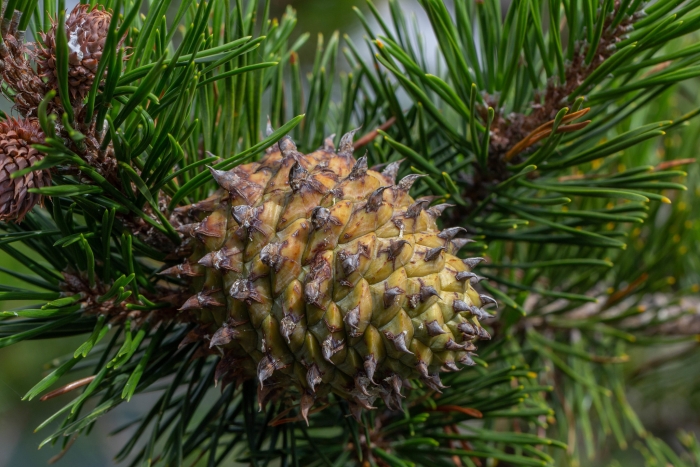Table Mountain Pine
(Pinus pungens)
Table Mountain Pine (Pinus pungens)
/
/

kirk gardner
CC BY 4.0
Image By:
kirk gardner
Recorded By:
Copyright:
CC BY 4.0
Copyright Notice:
Photo by: kirk gardner | License Type: CC BY 4.0 | License URL: http://creativecommons.org/licenses/by/4.0/ | Rights Holder: kirk gardner | Publisher: iNaturalist | Date Created: 2017-08-18T10:17:28-07:00 |





















































Estimated Native Range
Summary
Pinus pungens, commonly known as Table Mountain Pine, is an evergreen tree native to the dry, rocky ridges and slopes of the Appalachian Mountains in the United States. It typically grows to a modest size of 6–12 meters (20–39 feet) with a rounded, irregular crown. The needles, which are a distinctive feature, are in bundles of two or occasionally three, and are yellow-green to mid-green, fairly stout, and 4–7 centimeters (1.5–3 inches) long. This species is adapted to fire ecology, with thick bark to protect mature trees and serotinous cones that open to release seeds after exposure to heat. The pollen of Table Mountain Pine is released early in the season, which reduces the likelihood of hybridization with other pine species.
Table Mountain Pine is valued for its rugged appearance and adaptability to poor soils, making it suitable for reforestation projects and naturalistic plantings. It is also used for bonsai. Its ability to thrive with low water requirements makes it a good candidate for xeriscaping. In cultivation, it prefers full sun but can tolerate a range of soil drainage conditions. While it is not commonly found in the nursery trade, it can be a unique addition to a native plant garden or restoration area. Potential problems include susceptibility to pine beetle infestations and diseases such as white pine blister rust.CC BY-SA 4.0
Table Mountain Pine is valued for its rugged appearance and adaptability to poor soils, making it suitable for reforestation projects and naturalistic plantings. It is also used for bonsai. Its ability to thrive with low water requirements makes it a good candidate for xeriscaping. In cultivation, it prefers full sun but can tolerate a range of soil drainage conditions. While it is not commonly found in the nursery trade, it can be a unique addition to a native plant garden or restoration area. Potential problems include susceptibility to pine beetle infestations and diseases such as white pine blister rust.CC BY-SA 4.0
Plant Description
- Plant Type: Tree
- Height: 30-40 feet
- Width: 5-35 feet
- Growth Rate: Slow
- Flower Color: N/A
- Flowering Season: Non-Flowering
- Leaf Retention: Evergreen
Growth Requirements
- Sun: Full Sun
- Water: Low
- Drainage: Fast, Medium, Slow
Common Uses
Bird Garden, Deer Resistant, Drought Tolerant, Fragrant, Low Maintenance, Rabbit Resistant, Rock Garden, Salt Tolerant
Natural Habitat
Dry, rocky ridges and slopes of the Appalachian Mountains
Other Names
Common Names: Hickory Pine , Table-Mountain Pine , Prickly Pine , Mountain Pine , Stechkiefer , 풍겐스소나무
Scientific Names: Pinus pungens , Pinus montana
GBIF Accepted Name: Pinus pungens Lamb.